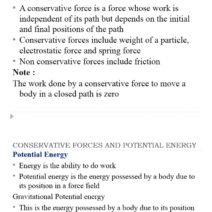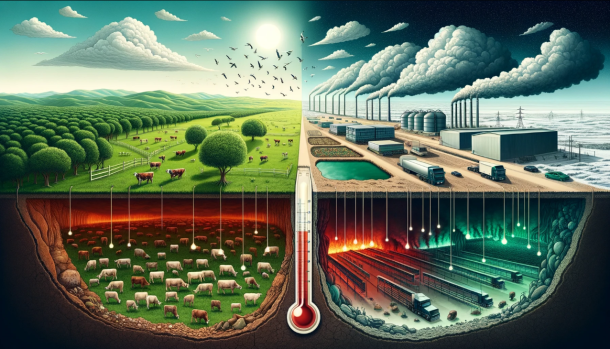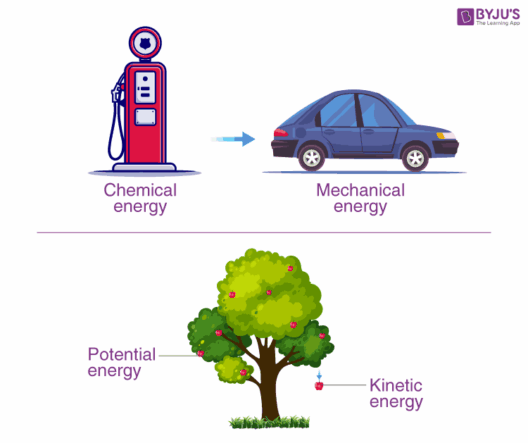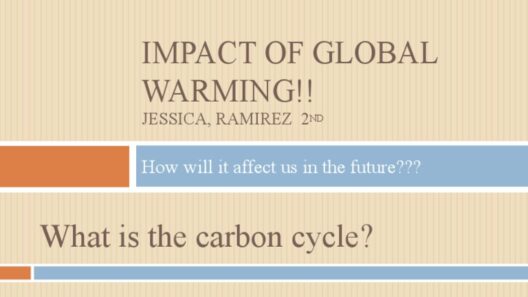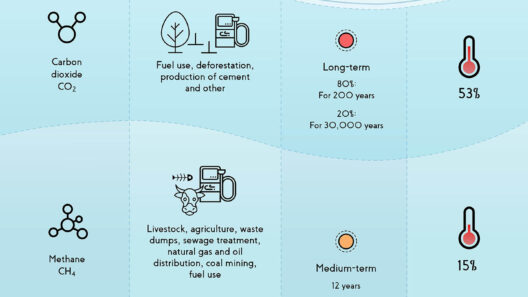The Silent Contributor: Unveiling Methane’s Role in Climate Change
Methane, a gas often overlooked in discussions surrounding climate change, possesses a potency that is staggering. While carbon dioxide (CO2) retains the spotlight, methane’s contributions to global warming are profound and require meticulous scrutiny. With a global warming potential over 25 times that of CO2 over a century, understanding methane’s dynamics provides critical insights into the ongoing climate crisis. This exploration not only underscores methane’s impact but also elucidates its sources, longevity in the atmosphere, and the measures needed to mitigate its effects.
The Methane Mystery: What Is It and Where Does It Come From?
Methane (CH4) is a hydrocarbon with a simple molecular structure, yet its implications bear complex ramifications. It is a colorless and odorless gas, flaring to life in multiple environments. Agricultural practices, particularly enteric fermentation in livestock, contribute significantly to methane emissions. Cattle produce methane during digestion, which is then expelled through belching—a phenomenon responsible for a substantial chunk of agricultural emissions. Other agricultural activities, including rice cultivation, also emit this potent greenhouse gas.
Outside agriculture, the fossil fuel industry represents another major source. Natural gas extraction, oil refining, and coal mining release methane at numerous points in the supply chain, from production to transportation. Methane leaks—a phenomenon euphemistically termed “fugitive emissions”—outweigh the emissions from smokestacks and tailpipes combined, suggesting an urgent need for inspection and remediation. Moreover, methane is released during the decomposition of organic matter in landfills, creating a trifecta of sources that highlight its omnipresence in human activities.
Beyond human influence, natural events also play a role. Wetlands, one of the planet’s most prolific methane producers, emit the gas through organic matter decomposition in anaerobic conditions. Additionally, thermokarst—a phenomenon occurring in thawing permafrost—leads to methane release, presenting a double threat as climate change accelerates the melting of these icy reserves. Understanding these sources emphasizes the multifaceted nature of methane as both a consequence and a contributor to climate change.
Longevity and Atmospheric Action: Why Methane Matters
One of the most intriguing characteristics of methane is its longevity in the atmosphere. While methane breaks down more quickly than CO2, with a lifespan of approximately a decade, it wreaks havoc during its residence. It decomposes through a series of photochemical reactions, primarily involving hydroxyl radicals, but the initial years are where its potency is felt. In many ways, methane can be viewed as a bridge between immediate climate action and long-term sustainability. The initial decade of high radiative forcing can prompt accelerated climate shifts, potentially locking in long-term changes that could destabilize ecosystems.
The immediate impact of methane accentuates the urgency for targeted mitigation strategies. Efforts to curb methane emissions, particularly through improved agricultural practices, waste management enhancements, and technological advances in the energy sector, represent a low-hanging fruit in the fight against climate change. Addressing methane leaks from oil and gas operations or adopting practices such as anaerobic digestion in livestock management can yield immediate climate benefits, effectively buying time to strategize longer-term plans against CO2.
Confronting the Challenge: Mitigation and Innovations
The pathway to mitigating methane emissions is paved with innovation and resolute commitment. Enhanced monitoring techniques utilizing satellite technology and aerial surveys allow for more precise identification of methane leaks across vast landscapes. The implementation of stricter regulations governing emissions in industries such as natural gas and agriculture is imperative. Transitioning to renewable energy sources can further diminish methane emissions, illustrating the interconnectedness of various environmental initiatives.
Moreover, fostering sustainable agricultural practices is paramount. Innovations, such as breeding enteric-fermentation-resistant cattle or adopting dietary modifications for livestock, can mitigate emissions significantly. Farmers are increasingly exploring the integration of cover crops and agroforestry, which not only improves soil health but also sequesters carbon, disengaging methane generation processes. The adoption of such practices heralds a paradigm shift in how agriculture can align with climate goals.
Public awareness plays a pivotal role in spurring governmental and corporate action to curtail methane emissions. Educating communities on the impacts of methane can rally support for climate initiatives and sustainable practices. By weaving together policy, innovation, and community engagement, society can collectively pivot from a trajectory of relentless emissions to one of regenerative practices that heal the planet.
The Path Forward: A Collective Responsibility
As the discourse surrounding climate change evolves, revisiting methane’s impact is essential for informed decision-making. This potent greenhouse gas is emblematic of broader systemic issues connected with energy production, agriculture, and waste management. Each of us plays a role in the fight against climate change, whether through personal choices or advocating for policy changes that address methane emissions effectively. The challenge is formidable, yet the potential for rapid climate improvement through targeted intervention offers hope.
By acknowledging methane’s role and understanding its implications, a collective consciousness can foster a sense of responsibility. Working together, communities can contribute to mitigating climate change, ensuring a sustainable future for generations to come. Climate change is more than an environmental issue—it’s a call to action, one that can reverberate through our choices and drive transformative change. Methane’s influence reminds us that the fight against climate change is not just a distant battle; it is an immediate and pressing reality that demands our attention and action.


